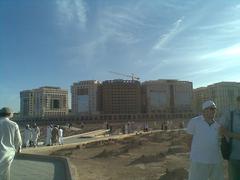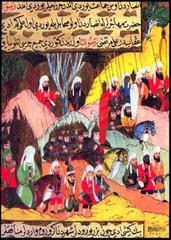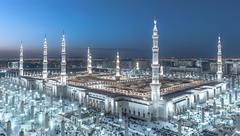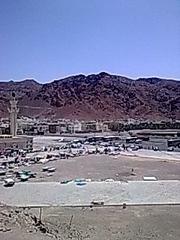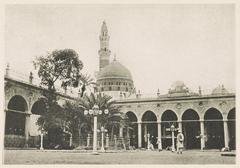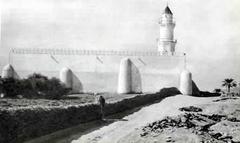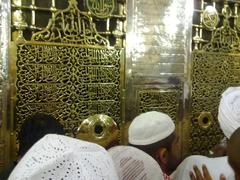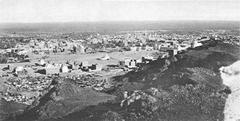Maktabat Al-Masjid Al-Nabawī Al-Sharīf Visiting Hours, Tickets, and Medina Historical Sites Guide
Date: 03/07/2025
Introduction: The Spiritual and Scholarly Heart of Medina
Al-Masjid al-Nabawi, the Prophet’s Mosque, stands as one of Islam’s holiest and most historically significant sites, located in Medina, Saudi Arabia. Established in 622 CE by Prophet Muhammad (ﷺ), the mosque has evolved from a humble place of worship into a revered center of spirituality, community life, and Islamic scholarship. One of its most distinguished features is the Maktabat Al-Masjid Al-Nabawī Al-Sharīf—the mosque’s historic library—which holds a priceless collection of manuscripts and serves as a beacon for scholars and pilgrims alike.
This comprehensive guide details the mosque’s rich history, the evolution and significance of its library, practical visitor information (including hours, entry requirements, and accessibility), and highlights other key historical sites in Medina. Whether you are a pilgrim, researcher, or cultural traveler, this article equips you with essential knowledge and tips for a respectful and meaningful visit (Madain Project, Audiala, The Islamic Information).
Contents
- Early Foundations of Masjid al-Nabawi and Its Library
- Historical Expansions: Umayyad, Abbasid, Mamluk, and Ottoman Eras
- Destruction, Decline, and Saudi Reestablishment of the Library
- Modern Developments: Saudi Expansions and Digital Transformation
- Architectural and Cultural Significance
- Visiting Masjid al-Nabawi: Hours, Tickets, Accessibility, and Tips
- Special Events, Guided Tours, and Amenities
- Frequently Asked Questions (FAQ)
- Visuals, Media, and Interactive Resources
- Preservation and Maintenance Efforts
- Key Milestones in the Library’s History
- Summary and Visitor Recommendations
- Sources and Further Reading
Early Foundations of Masjid al-Nabawi and Its Library
The origins of Masjid al-Nabawi are intimately tied to the birth of the Muslim community in Medina. Built by Prophet Muhammad (ﷺ) soon after his migration from Mecca, the mosque’s first structure was modest: palm trunks for pillars, mud walls, and a roof of palm leaves. It functioned as a mosque, community center, court, and school, with the suffah (a shaded platform) serving as an early hub for religious education and contemplation (Islamic Architectural Heritage). This spirit of learning laid the groundwork for what would become the mosque’s library.
Historical Expansions and the Library’s Development
Umayyad and Abbasid Periods
The first major expansion took place under Umayyad Caliph Al-Walid ibn Abd al-Malik (705–715 CE), who rebuilt the mosque with stone and integrated the Prophet’s tomb within its walls. The Abbasid Caliph al-Mahdi later increased the mosque’s size and added new entrances. These expansions cemented the mosque’s role as an intellectual and spiritual hub, encouraging the growth of its manuscript collections and the informal formation of a library (Madain Project).
Mamluk and Ottoman Contributions
During the Mamluk era, the mosque’s structure was enhanced with a dome over the Prophet’s tomb and new ablution facilities. Following a devastating fire in 1481 CE, Sultan Qaitbay oversaw reconstruction and established the first formal library, Maktabat al-Masjid al-Nabawi, making it one of Medina’s oldest libraries. The Ottomans maintained and expanded the mosque, enriching its scholarly tradition and architectural grandeur (Madain Project, Islamic Architectural Heritage).
Destruction, Decline, and Saudi Reestablishment
A catastrophic fire in 1482 destroyed large portions of the mosque and its library. Despite this loss, the legacy of learning endured. In the 20th century, under Saudi rule, the library was formally reestablished and endowed, marking a new era of systematic collection, preservation, and cataloging of religious texts (Madain Project).
Modern Developments: Saudi Expansions and Digital Transformation
With the formation of the Kingdom of Saudi Arabia, Masjid al-Nabawi underwent several expansions to accommodate millions of worshippers. The library grew in tandem, moving to a dedicated wing and adopting modern amenities such as air conditioning, digital catalogues, and climate-controlled preservation for rare manuscripts. Recent expansions under King Abdullah aim to welcome up to two million worshippers, with the library at the forefront of educational outreach and digitization (Madain Project).
Architectural and Cultural Significance
The Maktabat al-Masjid al-Nabawi seamlessly integrates with the mosque’s architectural tapestry, reflecting traditional Islamic, Ottoman, and contemporary Saudi influences. Its exterior features white marble, geometric motifs, and elegant calligraphic details mirroring the mosque’s minarets and the Green Dome. Inside, marble columns, lofty arches, and intricate ornamentation provide an inspiring atmosphere for study and devotion. Technological enhancements, including digital research tools and advanced security, coexist with the library’s historical character (Madain Project, The Islamic Information).
Visiting Masjid al-Nabawi: Hours, Tickets, Accessibility, and Tips
Visiting Hours
- Mosque: Open daily from after Fajr (dawn) prayer until late evening, with brief closures during midday prayers. Extended hours during Ramadan and Hajj.
- Library: Generally open from 8:00 AM to 9:00 PM, closing briefly for prayer times (The Islamic Information).
- Rawdah: Access via permit obtained through the Nusuk app; specific hours for men and women.
Entry and Ticketing
- Entry Fee: Both the mosque and library are free to enter for Muslims; no tickets required.
- Permits: Permit required via the Nusuk app for Rawdah access.
Accessibility
- Ramps, elevators, and wide pathways accommodate visitors with disabilities.
- Dedicated prayer and family areas ensure comfort for women and children.
Visitor Guidelines
- Dress Code: Men should wear long trousers and shirts; women must wear abayas and cover their hair.
- Behavior: Maintain silence and reverence, especially in prayer and study areas. Photography is restricted in certain zones—follow posted signs.
- Security: Bag inspections and metal detectors at entrances; carry identification.
- Essentials: Remove shoes before entering prayer and library areas; lockers are available for personal items.
Travel Tips
- Visit during non-peak hours (mid-morning or early afternoon) for a quieter experience.
- Use mosque navigation apps or printed maps for easy orientation.
- Hydration stations are available; eating and drinking in prayer areas is prohibited.
- Supervise children and keep mobile devices on silent.
Special Events, Guided Tours, and Amenities
The mosque hosts Qur’an recitation competitions, religious lectures, and educational seminars, especially during Ramadan and Hajj. Guided tours are available through authorized channels, and the library offers group tours by advance arrangement. Amenities include rest areas, ablution facilities, and multilingual staff support (The Islamic Information).
Frequently Asked Questions (FAQ)
Q: What are the visiting hours for Masjid al-Nabawi and its library?
A: The mosque is open daily from dawn until late evening. The library operates from 8:00 AM to 9:00 PM, with short closures during prayer times.
Q: Is there an entry fee or ticket required?
A: No, entry is free. However, a permit via the Nusuk app is required to access the Rawdah area.
Q: Are non-Muslims allowed to enter?
A: No, entry to both the mosque and library is reserved for Muslims.
Q: Can I take photos inside?
A: Photography may be restricted in certain areas; always follow posted guidelines.
Q: Are guided tours available?
A: Yes, guided mosque tours and group library visits can be arranged in advance.
Q: Is the library accessible to researchers?
A: Yes, with staff support and special access for rare materials upon request.
Visuals and Interactive Resources
- High-quality images of the mosque’s exterior, Green Dome, and library interior enhance the visitor experience.
- Interactive maps and virtual tours are available through official websites and apps.
- Suggested alt text: “Al-Masjid an-Nabawi visiting hours,” “Maktabat Al-Masjid Al-Nabawi library interior,” “Medina historical sites.”
Preservation and Maintenance
The Saudi authorities maintain a rigorous 24-hour preservation program, ensuring the physical integrity and security of the mosque and its library. Investments in climate control, digitization, and restoration safeguard both the manuscripts and the architectural heritage (Islamic Architectural Heritage).
Key Milestones in the Library’s History
- 1481 CE: Library established after Mamluk reconstruction.
- 1482 CE: Fire destroys mosque and library.
- 1933/34 CE: Library reestablished by Saudi authorities.
- 1951–1973 CE: Major expansions and modernization.
- 2012–Present: Ongoing digital transformation and facility upgrades.
Summary and Visitor Recommendations
Visiting Maktabat Al-Masjid Al-Nabawī Al-Sharīf and the larger Masjid al-Nabawi complex is a journey through the heart of Islamic history, spirituality, and scholarship. The mosque’s evolution from a simple gathering place to a grand, modern sanctuary underscores its enduring importance to Muslims worldwide. The library, with its rich collections and accessible facilities, continues to inspire scholars and serve the global Muslim community.
Entry is free, with comprehensive accessibility, clear visitor guidance, and robust preservation efforts ensuring a dignified and welcoming experience. To enrich your visit, use official apps such as Audiala for real-time updates, and consider guided tours or exploring other historical sites in Medina.
Whether you seek spiritual fulfillment, academic research, or cultural exploration, Al-Masjid an-Nabawi and its library remain unparalleled destinations that embody the enduring legacy of Islamic civilization (Madain Project, Audiala, The Islamic Information).
Sources and Further Reading
- Masjid al-Nabawi Library and Visiting Hours: History, Tickets, and Medina’s Historical Sites, 2024, Madain Project
- Al-Masjid an-Nabawi in Medina: Visiting Hours, Tickets, and Cultural Significance, 2024, Madain Project
- Visiting Maktabat Al-Masjid Al-Nabawī Al-Sharīf: Architectural Features, Hours, Tickets, and Visitor Guide, 2024, The Islamic Information
- Visitor Experience and Practical Information for Al-Masjid an-Nabawi: Visiting Hours, Entry, and Insights into the Prophet’s Mosque and Library, 2024, UmrahMe Blog
- Audiala Mobile App, 2024
- Islamic Architectural Heritage: Al-Masjid An-Nabawi, 2024
Ready to explore more? Download the Audiala app for guided tours, interactive maps, and real-time updates. Follow us on social media for the latest news, travel tips, and detailed articles about Medina and its historical treasures.
